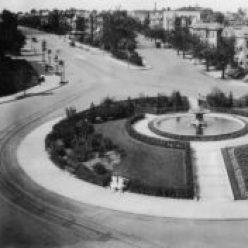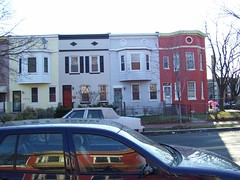Prince of Petworth has “Reader Finds Remnants of Truxton Circle.”
and though posted yesterday, but the comments are from today…
BACA Blog asks What’s in a Name? particularly the name Truxton Circle.
And during my lunch hour I created this bibliography thing about the TC and the WP. Click comment to see it all.
History of the term “Truxton Circle” in the Washington Post
[Method search “Truxton Circle” in ProQuest looking for articles only prior to 01/01/1940 in the Washington Post, which includes the Washington Star. Not all articles are cited.]
THE DISTRICT SURVEYOR.; Recommendations About the Preservation of Plats and Records. The Washington Post (1877-1954). Washington, D.C.: Aug 1, 1891. p. 5 (1 page)- regarding surveys for proposed circles. This is the earliest mention of the TC found.
ASKS DISTRICT TO PAY; Dog Catchers Caused Injury to a Bicycle. CHASED BULLDOG, BROKE A WHEEL Animal in Attempting to Escape the Net Ran Into the Bicycle of P.J. Nee, Who Claims Damages — District Auditor Approved Application and Recommends Payment — Plants from Mount Vernon Square to Decorate Other Reservations. The Washington Post. Mar 15, 1900. p. 12 (1 page) – Shrubbery for the circle. No mention of the Knights who say shrubbery.
AFFAIRS OF ECKINGTON.; Mr. Macfarland Opposed to Citizens’ Associations’ Candidate for School Board. The Washington Post (1877-1954). Washington, D.C.: Jun 26, 1900. p. 2 (1 page)- Mentions moving a fountain at Pennsylvania, M and 26th to “Truxton Circle in Eckington.” Citizens associations tended to be white, and the Eckington Citizen Association I’ve noticed stuck their noses in the affairs of things south of Florida Avenue to about New York Avenue. Prior to 1900 the TC wasn’t heavily populated, in 1880 there were less than 1,000 persons living in the area.
MR. MACFARLAND THEIR GUEST.; Commends Interest of Citizens’ Association in Public Affairs. The Washington Post (1877-1954). Washington, D.C.: May 28, 1901. p. 8 (1 page)- Mentions the Eckington and North Capitol Citizen Associations, and them thanking the city for the fountain at Truxton Circle.
SALE OF SIX HOMES SHOW PRICES HIGH The Washington Post (1877-1954). Washington, D.C.: Apr 27, 1919. p. R6 (1 page)- 51 Q Street NE (modern Eckington) being described as near Truxton Circle. In same article Dupont Circle is described as a neighborhood. TC not described as such.
$110,500 IN SALES OF HOMES IN CITY; Houses Fetch $17,500 Disposed by Hartung & Gibbons. The Washington Post (1877-1954). Washington, D.C.: Nov 7, 1920. p. 34 (1 page). 149 Bates Street sold and described as being near North Capitol and Truxton Circle. In same article, Bloomingdale described as ‘an attractive area’.
RYAN QUITS CENTRAL CITIZENS’ PRESIDENCY; Will Head Movement to Form Another Association in Same Territory. SECTION CALLED TOO BIG The Washington Post (1877-1954). Washington, D.C.: Apr 26, 1925. p. 2 (1 page)- Mr. Francis J. Ryan proposes a new citizens association that would have borders from NY Ave, Truxton Circle, and New Jersey Avenue……
AUTO SIGNAL LIGHTS TO BE READY DEC. 15; Sixteenth Street Crossings and Truxton Circle to Be Equipped. The Washington Post (1877-1954). Washington, D.C.: Nov 14, 1925. p. 20 (1 page)- Truxton Circle gets a traffic light.
Girl Drives with Arm Around Poodle; Fined. The Washington Post (1877-1954). Washington, D.C.: Jul 9, 1926. p. 22 (1 page)- In sub article, people are skinny-dipping in the Truxton Circle fountain.
$15,000 Asked in Suit For Alleged Injury. The Washington Post (1877-1954). Washington, D.C.: Aug 13, 1926. p. 20 (1 page)- Woman Sues streetcar company because of injury in a car at the TC.
NOTES OF DEPARTMENTAL PERSONNEL; News of Departments
The Washington Post (1877-1954). Washington, D.C.: Jun 19, 1927. p. S10 (2 pages)- Mention of Truxton Circle Station Post Office. The post office will out live the circle.
400 CARRIERS NAMED FOR CHRISTMAS MAIL; Postmaster to Appoint Equal Number of Clerks for the Holiday Rush. BARGAIN DAYS ANNOUNCED
The Washington Post (1877-1954). Washington, D.C.: Dec 11, 1927. p. 2 (1 page)- Post office. Other post offices mentioned are U Street and Petworth.
$25,000 Asked for Injuries. The Washington Post (1877-1954). Washington, D.C.: Jul 11, 1928. p. 8 (1 page)- Did they have a phone and if so, did they have a lawyer? Lawsuit regarding traffic accident at Truxton Circle.
Washington’s Fountains Temper Summer’s Heat; Increased Supply of Water Due to the New Filtration Plant on Conduit Road Enables the City to Keep Fountains Going More Regularly Than in the Past — Boon to Children and Other Stay-at-Homes. Washington’s Fountains Temper Summer Heat, by Victoria Faber Stevenson.. The Washington Post (1877. Jul 29, 1928. p. SM3 (2 pages)- Mentions how the Truxton fountain in Truxton Circle was becoming a landmark.
MAN DIES TWO HURT IN MOTOR MISHAPS; Driver of Truck Is Instantly Killed When Crushed Against Radiator. LAD PAINFULLY INJURED. The Washington Post (1877-1954). Washington, D.C.: Dec 17, 1929. p. 5 (1 page)- First noted traffic death at the circle. The problem was truck was overloaded with granite and crushed driver.
Bandit Pair Robs 2 Filling Stations; First and H and Wisconsin and Q Gasoline Depots Are Victimized. The Washington Post (1877-1954). Washington, D.C.: Dec 27, 1932. p. 14 (1 page)- First noted robbery of Truxton Circle post office at 17 Florida Ave NE.
[article search 1940-1999]
Post Office Bandits Get $500 Here, The Washington Post, Times Herald (1959-1973). Washington, D.C.: Jul 24, 1965. p. A3 (1 page)- Last mention of Truxton Circle post office getting robbed.
Subsidy Program’s Nuts and Bolts, The Washington Post (1974-Current file). Washington, D.C.: Aug 2, 1984. p. A15 (1 page)- Truxton Circle first mentioned as a neighborhood as a target area for mortgage subsidies.
D.C. Cable Firm Unveils Wiring Schedule, Seeks More Concessions; D.C. Cable Firm Tells 5-Year Plan, Seeks Concessions , by Marcia Slacum Greene Washington Post Staff Writer. The Washington Post (1974-Current file). Washington, D.C.: Sep 4, 1985. p. C1 (2 pages)- Another article mention of Truxton Circle in listing of neighborhoods to get cable.
Community Outcry Wins Reprieve for Lenny’s; Bank Delays Evicting Popular Neighborhood Store Until Buyer for Building Is Found by Elizabeth Wiener Special to The Washington Post. The Washington Post (1974-Current file). Oct 31, 1991. p. DC2 (1 page)- Quote” I understand the position Riggs [National Bank] is in – they just want to download the property, and they’re within their rights, “ said Kathy Glynn, chairman of the Truxton Circle Coalition, an umbrella group for civic associations in the area. “But we’re really getting tired of the constant destabilization of businesses moving out because of crime and real estate turnovers. This is a store people rely on.”



